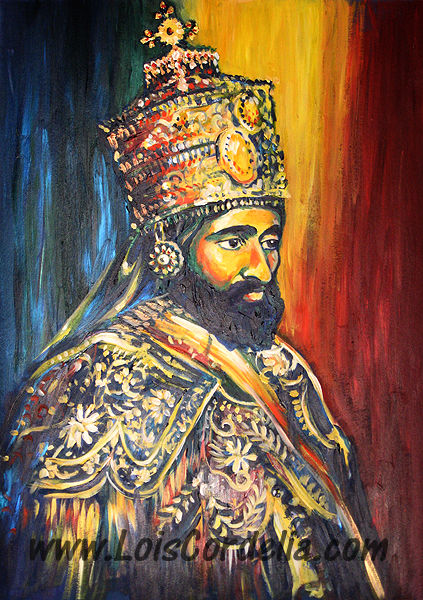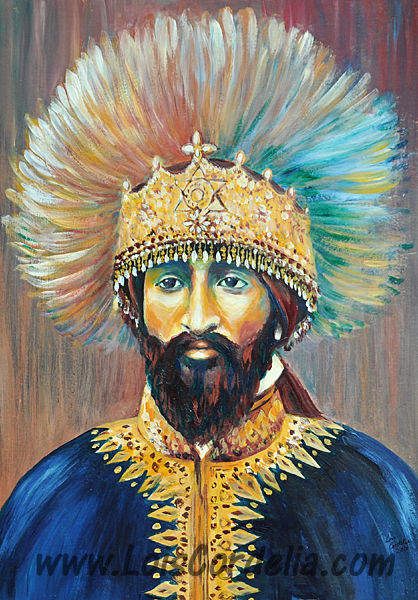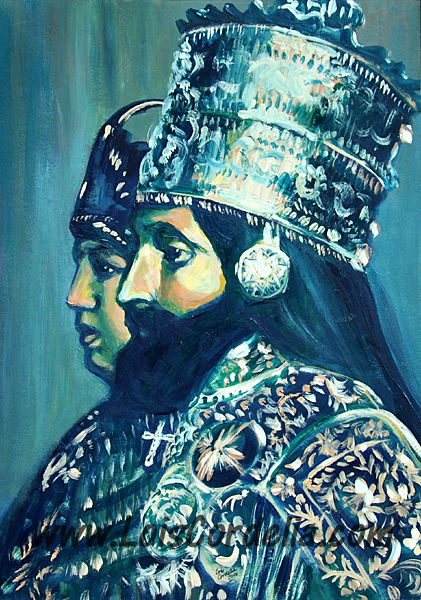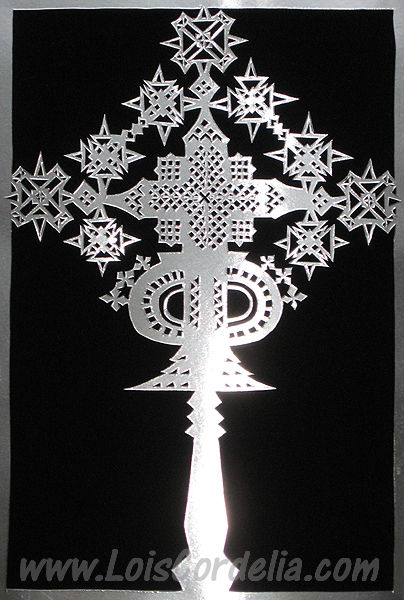











 |
His Imperial Majesty Emperor
Haile Selassie I

Born in 1892, Haile Selassie became king of Ethiopia in 1928. Later, on 2nd November 1930, he
also became Emperor and henceforth ruled under the title
of His Imperial Majesty Emperor Haile Selassie I.
His reign has often been described as 'enlightened', as
he abolished slavery, aimed to modernise Ethiopia, and
gave his country its first written constitution
(1931). In 1935, Italian fascists invaded Ethiopia, and
Selassie fought bravely until forced to flee to Britain
where he sought help to ultimately successfully repel the
invasion.

Selassie I was believed to be directly descended from King
Solomon of Israel (circa 970-931 B.C.E) and the
Black Queen Makeda of Sheba. The
biblical description (1 Kings
10:1-13) of the
meeting of these two legendary figures of Israel's Golden
Age makes no mention of their supposed union. But an
elaborated version of the tale is related in an ancient
Ethiopian document, the Kebra Nagast
('Glory of Kings'), which claims they became the parents
of a son Menelik. According to the
tradition, Menelik not only went on to found a royal
dynasty in Ethiopia, from which Haile Selassie I claimed
descent, but he also stole the Ark
of the Covenant from his father Solomon's Temple in
Jerusalem, and took it with him to Ethiopia. (This has
never been proven, though it is a fact that the Ark
mysteriously disappeared from the Temple's Holy of
Holies, probably during the reign of Solomon and in any
case long before the Fall of Jerusalem in 589 B.C.E.)

The Kebra Nagast legend has various implications. The
theory of the Ark's removal from Israel to Ethiopia
conveys an obvious symbolism: in effect, God's favour was
being taken away from his original Chosen People and
bestowed instead upon Ethiopia. Hence, God's covenant promise
to King David that he would never lack a descendant to
rule over Israel was believed to have been similarly
transferred to the Ethiopian royal lineage descended from
Menelik, son of Solomon and Sheba. This is taken to
explain why the line of Israel's Davidic monarchs
eventually ended in failure at the time of the Fall of
Jerusalem. (The Christian interpretation of this apparent
broken promise on God's part seems to be that Jesus Christ, who was similarly said to be a
descendant of King David, is the heir to Israel's throne
in a wider ranging spiritual sense.)

Thus Haile Selassie I was seen to be preserving an
important scriptural tradition that stretched back over
three millennia. Moreover, as Ethiopia's monarch, he
adopted various biblical titles that
have long been connected with the Messiah
- Selassie was called King of kings and
Lord of lords, and was also associated with the motto, 'The Lion Of The Tribe
Of Judah [hath prevailed]'.
Meanwhile, in Jamaica it was said that Selassie's coronation in
1930 was the dramatic fulfilment of a prophecy
spoken by Marcus Garvey who had predicted the crowning
in Africa of a Black king, who would be the Redeemer
of the worldwide Black African Diaspora.
Selassie's illustrious legendary background and messianic
titles must have left many of Garvey's followers in no
doubt that this was the promised Black Messiah.
Moreover, the name 'Haile Selassie' (Amharic, 'Power of the Trinity')
implied a divine presence incarnate in man.
Thus Haile Selassie began to be variously adored or
worshipped as a Christ figure or even as Almighty God.
His devoted Jamaican followers became known as Rastafarians,
a term derived from Haile Selassie's given name at birth,
Ras Tafari Mekonnen.

Selassie himself being a devout Orthodox
Christian, he
seems to have found this attention embarassing. He sought
to assure people that he was not God, but a sinner for
whom Jesus Christ had died. However, this did
little to halt the growth of the Rastafarian movement,
for it was reasoned that God incarnate in a man would by
his very nature not know that he was God.
As various branches of the Rastafarian tradition have
evolved, some groups have continued to worship the Divinity
of Haile Selassie, the Power of the Trinity, while others
(such as the Twelve Tribes) have come to view him as an
enlightened ruler and christ figure who pointed the way
to God though was not God himself.
In contrast to the vast respect he was afforded by many
in Jamaica, Selassie was condemned as a ruthless
dictator by a number of enemies and political opponents,
notably some neighbouring African countries. Evidently,
controversy - both religious and political - has centred
around many aspects of his reign.
Selassie I was eventually deposed by the Marxist leader Mengistu
Haile Mariam in 1974. According to history
books, Selassie died the following year in mysterious
circumstances, having been imprisoned and presumably
tortured. However, Rastafarians who believed him to be
the immortal God Jah Rastafari claimed that this was mere enemy
propaganda, and that Selassie I was still alive.
Whatever the case historically, H.I.M. Emperor Haile
Selassie I has undeniably gone into legend and continues
to inspire a vast following today.
Back to 'Key Biblical Concepts
In Rasta Reggae Lyrics' page

|

